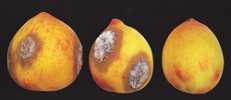Ten Tips For Controlling Fruit Rot

On mature fruit, decays develop either in the field or soon after harvest. On immature fruit, quiescent infections are established that can develop into active decay at fruit ripening later in the season. Spring rain will also affect decay incidence of late-maturing fruit. Rain cracks and split pits are direct entry points for Monilinia species and Botrytis cinerea (gray mold).
Preventive Medicine
Decay management cannot depend on a postharvest fungicide alone. Scholar (fludioxonil, Syngenta Crop Protection) and Elevate (fenhexamid, Arysta LifeScience) are fully registered as postharvest fungicides on all stone fruits in California. Any established infections, however, cannot be eradicated or managed effectively except by strict sorting practices. Thus, an integrated decay management approach is the only option to get high-quality fruit to the consumer in a high-risk disease year. This includes preharvest fungicide treatments to inhibit new infections on the highly susceptible maturing fruit, careful sorting to remove injured fruit, and a postharvest fungicide treatment.
Top 10 Tips
The following 10 guidelines are suggested for decay control this season:
1. Identify orchards with a history of brown rot. They will be at greater risk in a wet year.
2. Monitor orchards for any fruit with brown rot during fruit development. Decayed fruit on the tree is an indication of high inoculum levels in the orchard.
3. Use preharvest treatments within 14 days of harvest.
4. Use SBI fungicides such as Elite (tebuconazole, Bayer CropScience), Orbit (propiconazole, Syngenta), and Indar (fenbuconazole, Dow AgroSciences) against brown rot.
5. Minimize injuries during harvest and transportation to the packinghouse.
6. Hydrocool fruit with chlorinated water. Be sure to change the water in the hydrocoolers daily to prevent buildup of organic load (organic material directly inhibits the activity of chlorine on microbial populations).
7. Be sure to use chlorinated water (and possibly detergents) on the brush beds to minimize contamination of equipment and subsequent inoculation of fruit.
8. Treat fruit with postharvest fungicides at registered rates within 18 hours of harvest. Lower rates than 8 ounces per 200,000 pounds are ineffective on peaches, plums, and nectarines to maintain commercial decay management standards for all major decays and may result in the development of resistant populations of pathogens.
9. Sort fruit to remove off-grades and fruit with obvious injuries.
10. Carefully use temperature management practices throughout packing and transportation of fruit to the market.










